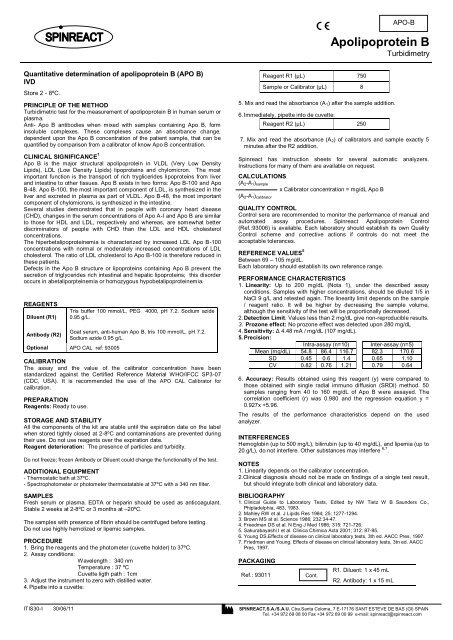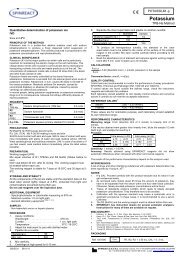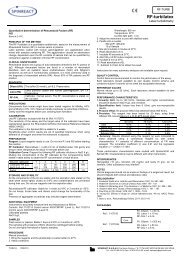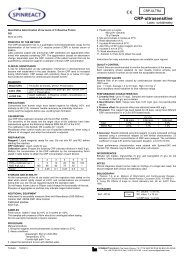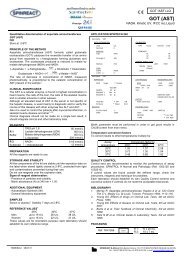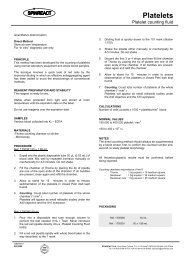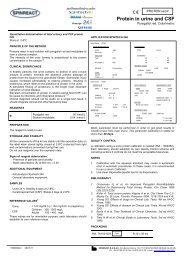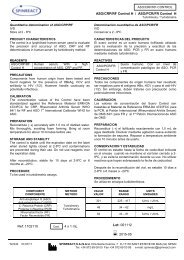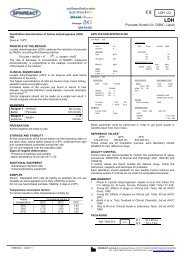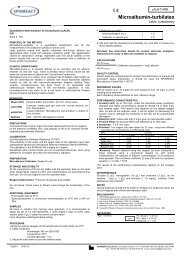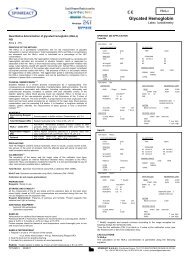Apolipoprotein B - Spinreact
Apolipoprotein B - Spinreact
Apolipoprotein B - Spinreact
Create successful ePaper yourself
Turn your PDF publications into a flip-book with our unique Google optimized e-Paper software.
Quantitative determination of apolipoprotein B (APO B)<br />
IVD<br />
Store 2 - 8ºC.<br />
PRINCIPLE OF THE METHOD<br />
Turbidimetric test for the measurement of apolipoprotein B in human serum or<br />
plasma.<br />
Anti- Apo B antibodies when mixed with samples containing Apo B, form<br />
insoluble complexes. These complexes cause an absorbance change,<br />
dependent upon the Apo B concentration of the patient sample, that can be<br />
quantified by comparison from a calibrator of know Apo B concentration.<br />
CLINICAL SIGNIFICANCE 1<br />
Apo B is the major structural apolipoprotein in VLDL (Very Low Density<br />
Lipids), LDL (Low Density Lipids) lipoproteins and chylomicron. The most<br />
important function is the transport of rich tryglicerides lipoproteins from liver<br />
and intestine to other tissues. Apo B exists in two forms: Apo B-100 and Apo<br />
B-48. Apo B-100, the most important component of LDL, is synthesized in the<br />
liver and excreted in plasma as part of VLDL. Apo B-48, the most important<br />
component of chylomicrons, is synthesized in the intestine.<br />
Several studies demonstrated that in people with coronary heart disease<br />
(CHD), changes in the serum concentrations of Apo A-I and Apo B are similar<br />
to those for HDL and LDL, respectively and whereas, are somewhat better<br />
discriminators of people with CHD than the LDL and HDL cholesterol<br />
concentrations.<br />
The hiperbetalipoproteinemia is characterized by increased LDL Apo B-100<br />
concentrations with normal or moderately increased concentrations of LDL<br />
cholesterol. The ratio of LDL cholesterol to Apo B-100 is therefore reduced in<br />
these patients.<br />
Defects in the Apo B structure or lipoproteins containing Apo B prevent the<br />
secretion of triglycerides rich intestinal and hepatic lipoproteins; this disorder<br />
occurs in abetaliporpteinemia or homozygous hypobetalipoproteinemia.<br />
REAGENTS<br />
Diluent (R1)<br />
Antibody (R2)<br />
Tris buffer 100 mmol/L, PEG 4000, pH 7.2. Sodium azide<br />
0.95 g/L.<br />
Goat serum, anti-human Apo B, tris 100 mmol/L, pH 7.2.<br />
Sodium azide 0.95 g/L.<br />
Optional APO CAL ref: 93005<br />
CALIBRATION<br />
The assay and the value of the calibrator concentration have been<br />
standardized against the Certified Reference Material WHO/IFCC SP3-07<br />
(CDC, USA). It is recommended the use of the APO CAL Calibrator for<br />
calibration.<br />
PREPARATION<br />
Reagents: Ready to use.<br />
STORAGE AND STABILITY<br />
All the components of the kit are stable until the expiration date on the label<br />
when stored tightly closed at 2-8ºC and contaminations are prevented during<br />
their use. Do not use reagents over the expiration date.<br />
Reagent deterioration: The presence of particles and turbidity.<br />
Do not freeze; frozen Antibody or Diluent could change the functionality of the test.<br />
ADDITIONAL EQUIPMENT<br />
- Thermostatic bath at 37ºC.<br />
- Spectrophotometer or photometer thermostatable at 37ºC with a 340 nm filter.<br />
SAMPLES<br />
Fresh serum or plasma. EDTA or heparin should be used as anticoagulant.<br />
Stable 2 weeks at 2-8ºC or 3 months at –20ºC.<br />
The samples with presence of fibrin should be centrifuged before testing.<br />
Do not use highly hemolized or lipemic samples.<br />
PROCEDURE<br />
1. Bring the reagents and the photometer (cuvette holder) to 37ºC.<br />
2. Assay conditions:<br />
Wavelength : 340 nm<br />
Temperature : 37 ºC<br />
Cuvette ligth path : 1cm<br />
3. Adjust the instrument to zero with distilled water.<br />
4. Pipette into a cuvette:<br />
Reagent R1 (µL) 750<br />
Sample or Calibrator (µL) 8<br />
APO-B<br />
<strong>Apolipoprotein</strong> B<br />
Turbidimetry<br />
5. Mix and read the absorbance (A1) after the sample addition.<br />
6. Immediately, pipette into de cuvette:<br />
Reagent R2 (µL) 250<br />
7. Mix and read the absorbance (A2) of calibrators and sample exactly 5<br />
minutes after the R2 addition.<br />
<strong>Spinreact</strong> has instruction sheets for several automatic analyzers.<br />
Instructions for many of them are available on request.<br />
CALCULATIONS<br />
(A2-A1)sample<br />
(A2-A1)calibrator<br />
x Calibrator concentration = mg/dL Apo B<br />
QUALITY CONTROL<br />
Control sera are recommended to monitor the performance of manual and<br />
automated assay procedures. <strong>Spinreact</strong> <strong>Apolipoprotein</strong> Control<br />
(Ref.:93006) is available. Each laboratory should establish its own Quality<br />
Control scheme and corrective actions if controls do not meet the<br />
acceptable tolerances.<br />
REFERENCE VALUES 5<br />
Between 69 – 105 mg/dL.<br />
Each laboratory should establish its own reference range.<br />
PERFORMANCE CHARACTERISTICS<br />
1. Linearity: Up to 200 mg/dL (Nota 1), under the described assay<br />
conditions. Samples with higher concentrations, should be diluted 1/5 in<br />
NaCl 9 g/L and retested again. The linearity limit depends on the sample<br />
/ reagent ratio. It will be higher by decreasing the sample volume,<br />
although the sensitivity of the test will be proportionally decreased.<br />
2. Detection Limit: Values less than 2 mg/dL give non-reproducible results.<br />
3. Prozone effect: No prozone effect was detected upon 280 mg/dL<br />
4. Sensitivity: Δ 4.48 mA / mg/dL (107 mg/dL).<br />
5. Precision:<br />
Intra-assay (n=10) Inter-assay (n=5)<br />
Mean (mg/dL) 54.8 86.4 116.7 82.3 170.6<br />
SD 0.45 0.6 1.4 0.65 1.10<br />
CV 0.82 0.76 1.21 0.79 0.64<br />
6. Accuracy: Results obtained using this reagent (y) were compared to<br />
those obtained with single radial immuno diffusion (SRDI) method. 50<br />
samples ranging from 40 to 160 mg/dL of Apo B were assayed. The<br />
correlation coefficient (r) was 0.980 and the regression equation y =<br />
0.927x +5.96.<br />
The results of the performance characteristics depend on the used<br />
analyzer.<br />
INTERFERENCES<br />
Hemoglobin (up to 500 mg/L), bilirrubin (up to 40 mg/dL), and lipemia (up to<br />
20 g/L), do not interfere. Other substances may interfere 6,7 .<br />
NOTES<br />
1. Linearity depends on the calibrator concentration.<br />
2.Clinical diagnosis should not be made on findings of a single test result,<br />
but should integrate both clinical and laboratory data.<br />
BIBLIOGRAPHY<br />
1. Clinical Guide to Laboratory Tests, Edited by NW Tietz W B Saunders Co.,<br />
Phipladelphia, 483, 1983.<br />
2. Mahley RW et al. J Lipids Res 1984; 25: 1277-1294.<br />
3. Brown MS at al. Science 1986; 232:34-47.<br />
4. Freedman DS et al. N Eng J Med 1986; 315: 721-726.<br />
5. Sakurabayashi I et al. Clinica Chimica Acta 2001; 312: 87-95.<br />
6. Young DS.Effects of disease on clinical laboratory tests, 3th ed. AACC Pres, 1997.<br />
7. Friedman and Young. Effects of disease on clinical laboratory tests, 3tn ed. AACC<br />
Pres, 1997.<br />
PACKAGING<br />
Ref.: 93011<br />
R1. Diluent: 1 x 45 mL<br />
R2. Antibody: 1 x 15 mL<br />
ITIS30-I 30/06/11 SPINREACT,S.A./S.A.U. Ctra.Santa Coloma, 7 E-17176 SANT ESTEVE DE BAS (GI) SPAIN<br />
Tel. +34 972 69 08 00 Fax +34 972 69 00 99 e-mail: spinreact@spinreact.com<br />
Cont.
Determinación cuantitativa de la Apolipoproteína B (APO B)<br />
IVD<br />
Conservar a 2 - 8ºC.<br />
PRINCIPIO DEL MÉTODO 1<br />
Ensayo turbidimétrico para la cuantificación de la apolipoproteína B en suero o<br />
plasma humano.<br />
Los anticuerpos anti-Apo B forman compuestos insolubles cuando se combinan<br />
con las Apo B de la muestra del paciente, ocasionando un cambio de absorbancia<br />
proporcional a la concentración de Apo B en la muestra, y que puede ser<br />
cuantificada por comparación con un calibrador de Apo B de concentración<br />
conocida.<br />
SIGNIFICADO CLÍNICO 1<br />
La Apo B es la principal apolipoproteína estructural asociada a las lipoproteínas de<br />
VLDL (Very Low Density Lipids), LDL (Low Density Lipids) y quilomicrones. Su<br />
función principal es la secreción de lipoproteínas ricas en triglicéridos desde el<br />
intestino y el hígado otros tejidos. La Apo B existe en dos formas distintas: Apo B-<br />
100, componente mayoritario de la LDL, sintetizada en el hígado y excretada en el<br />
plasma como parte de VLDL, y la Apo B-48, componente mayoritario de los<br />
quilomicrones y sintetizada en el intestino.<br />
Estudios diversos, muestran que individuos con enfermedad coronaria (CHD)<br />
sufren cambios en las concentraciones de Apo A-I y Apo B, parecidas a los<br />
cambios de concentración de HDL y LDL. Además, la concentración de Apo A-I y<br />
Apo B son mejores indicadores que la concentración de LDL y HDL colesterol.<br />
En la hiperbetalipoproteinemia, la concentración de LDL colesterol es normal o<br />
ligeramente baja, mientras que la concentración de Apo B-100 es<br />
significativamente elevada. La relación de la LDL colesterol y la Apo B-100 se<br />
reduce en estos pacientes.<br />
Los defectos en la estructura de Apo B o las lipoproteínas que contienen Apo B<br />
impiden la secreción de las lipoproteínas intestinales y hepáticas ricas en<br />
triglicéridos. Esta dislipoproteinemia se denomina abetalipoproteinemia o<br />
hipobetalipoproteinemia homocigótica.<br />
REACTIVOS<br />
Diluyente (R1)<br />
Anticuerpo (R2)<br />
Tris 100 mmol/L, PEG 4000, pH 7,2. Azida sódica 0,95<br />
g/L.<br />
IgG de cabra, anti-Apo B humana, tris 100 mmol/L, pH<br />
7,2. Azida sódica 0,95 g/L.<br />
Opcional: APO CAL ref: 93005<br />
CALIBRACIÓN<br />
La sensibilidad de los reactivos así como el valor de concentración del calibrador<br />
están estandarizados frente al Material de Referencia Certificado WHO/IFCC SP3-<br />
07 (CDC, USA). Se recomienda el uso del Calibrador APO CAL para la<br />
calibración.<br />
PREPARACIÓN<br />
Reactivos: Listos para el uso.<br />
CONSERVACIÓN Y ESTABILIDAD<br />
Todos los componentes del kit son estables hasta la fecha de caducidad cuando se<br />
mantienen los viales bien cerrados a 2-8ºC, y se evita la contaminación durante su<br />
uso. No utilizar reactivos que hayan sobrepasado la fecha de caducidad.<br />
Indicadores de deterioro: Presencia de partículas y turbidez.<br />
No congelar; la congelación del Anticuerpo o Diluyente puede afectar la<br />
funcionalidad de los mismos.<br />
MATERIAL ADICIONAL<br />
- Baño de agua a 37ºC.<br />
- Espectrofotómetro o fotómetro con cubeta termostatizable a 37ºC para lecturas a<br />
340 nm.<br />
MUESTRAS<br />
Suero o plasma fresco, recogido con heparina o EDTA como anticoagulantes.<br />
Estable 2 semanas a 2-8ºC o 3 meses a -20ºC.<br />
Las muestras con restos de fibrina deben ser centrifugadas.<br />
No utilizar muestras altamente hemolizadas o lipémicas.<br />
PROCEDIMIENTO<br />
1. Calentar los reactivos y el fotómetro (portacubetas) a 37ºC.<br />
2. Condiciones del ensayo:<br />
Longitud de onda: 340 nm<br />
Temperatura: 37ºC<br />
Paso de luz de la cubeta: 1 cm<br />
3. Ajustar el espectrofotómetro a cero frente a agua destilada.<br />
4. Pipetear en una cubeta:<br />
Reactivo R1 (µL) 750<br />
Muestra o Calibrador (µL) 8<br />
APO B<br />
Apolipoproteína B<br />
Turbidimetría<br />
5. Mezclar y leer la absorbancia (A1) después de la adición de la muestra.<br />
6. Inmediatamente después, pipetear en la cubeta:<br />
Reactivo R2 250 µL<br />
7. Mezclar y leer la absorbancia (A2) exactamente después de 5 minutos de<br />
añadir el reactivo R2.<br />
<strong>Spinreact</strong> dispone de adaptaciones detalladas a la mayoría de analizadores<br />
automáticos del mercado. Solicite la información a su distribuidor.<br />
CÁLCULOS<br />
(A2-A1)muestra<br />
(A2-A1)calibrador<br />
x concentración del Calibrador = mg/dL Apo B.<br />
CONTROL DE CALIDAD<br />
Se recomienda utilizar sueros control para controlar los ensayos tanto en<br />
procedimiento manual como en automático. <strong>Spinreact</strong> dispone del Suero APO<br />
Control ref: 93006.<br />
Cada laboratorio debería establecer su propio Control de Calidad y establecer<br />
correcciones en el caso de que los controles no cumplan con las tolerancias<br />
exigidas.<br />
VALORES DE REFERENCIA 5<br />
Entre 69– 105 mg/dL.<br />
Es recomendable que cada laboratorio establezca sus propios valores de<br />
referencia.<br />
CARACTERÍSTICAS DEL MÉTODO<br />
1. Límite de linealidad: hasta 200 mg/dL (Nota 1), en las condiciones descritas<br />
del ensayo. Las muestras con valores superiores deben diluirse 1/5 con ClNa<br />
9 g/L y ensayarse de nuevo. El intervalo de medida depende de la relación<br />
muestra/reactivo. Disminuyendo el volumen de muestra, se aumenta el límite<br />
superior del intervalo de medida, aunque se reduce la sensibilidad.<br />
2. Límite de detección: valores por debajo de 2 mg/dL dan lugar a resultados<br />
poco reproducibles.<br />
3. Sensibilidad: Δ 4.48 mA /mg/dL (107 mg/dL).<br />
4. Efecto prozona: No se observa efecto prozona hasta valores de 280 mg/dL.<br />
5. Precisión:<br />
Intraserie (n=10) Interserie (n=5)<br />
Media (mg/dL) 54.8 86.4 116.7 82.3 170.6<br />
SD 0.45 0.6 1.4 0.65 1.10<br />
CV 0.82 0.76 1.21 0.79 0.64<br />
6. Exactitud: El comportamiento de este método fue comparado con un método<br />
de inmunodifusión radial (SRID). Los resultados obtenidos no muestran<br />
diferencias significativas. 50 muestras de concentraciones de Apo B entre 40<br />
y 160 mg/dL fueron analizadas con ambos métodos. El coeficiente de<br />
regresión (r) fue de 0,980 y la ecuación de la recta de regresión y = 0.927x +<br />
5.96.<br />
Las características del método pueden variar según el analizador utilizado.<br />
INTERFERENCIAS<br />
Bilirrubina (40 mg/dL), hemoglobina (500 mg/dL) y lípidos (20 g/L), no<br />
interfieren. Otras sustancias pueden interferir 6-7<br />
NOTAS<br />
1. La linealidad depende del valor de concentración del calibrador utilizado.<br />
2. El diagnóstico clínico no debe realizarse únicamente con los resultados de un<br />
único ensayo, sino que debe considerarse al mismo tiempo los datos clínicos<br />
del paciente.<br />
BIBLIOGRAFÍA<br />
1. Clinical Guide to Laboratory Tests, Edited by NW Tietz W B Saunders Co.,<br />
Phipladelphia, 483, 1983.<br />
2. Mahley RW et al. J Lipids Res 1984; 25: 1277-1294.<br />
3. Brown MS at al. Science 1986; 232:34-47.<br />
4. Freedman DS et al. N Eng J Med 1986; 315: 721-726.<br />
5. Sakurabayashi I et al. Clinica Chimica Acta 2001; 312: 87-95.<br />
6. Young DS.Effects of disease on clinical laboratory tests, 3th ed. AACC Pres, 1997.<br />
7. Friedman and Young. Effects of disease on clinical laboratory tests, 3tn ed. AACC<br />
Pres, 1997.<br />
PRESENTACIÓN<br />
Ref.: 93011<br />
R1. Diluyente: 1 x 45 mL<br />
R2. Anticuerpo:1 x 15 mL<br />
ITIS30-E 30/06/11 SPINREACT,S.A./S.A.U. Ctra.Santa Coloma, 7 E-17176 SANT ESTEVE DE BAS (GI) SPAIN<br />
Tel. +34 972 69 08 00 Fax +34 972 69 00 99 e-mail: spinreact@spinreact.com<br />
Cont.


